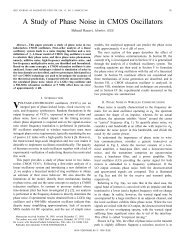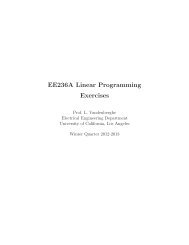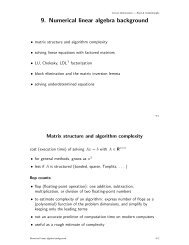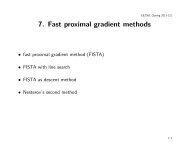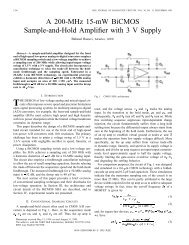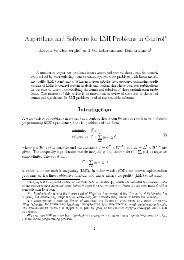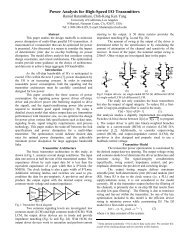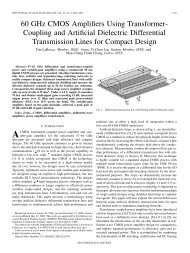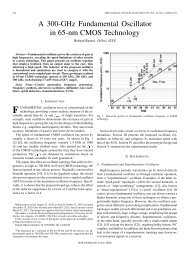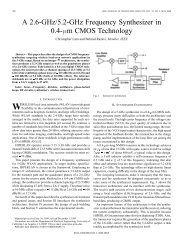Frequency Warping by Linear Transformation of Standard MFCC
Frequency Warping by Linear Transformation of Standard MFCC
Frequency Warping by Linear Transformation of Standard MFCC
Create successful ePaper yourself
Turn your PDF publications into a flip-book with our unique Google optimized e-Paper software.
<strong>Frequency</strong> <strong>Warping</strong> <strong>by</strong> <strong>Linear</strong> <strong>Transformation</strong> <strong>of</strong> <strong>Standard</strong> <strong>MFCC</strong><br />
Abstract<br />
A novel linear transform (LT) is proposed for frequency warping<br />
(FW) with standard filterbank based <strong>MFCC</strong> features. Here, we<br />
use the idea <strong>of</strong> spectral interpolation <strong>of</strong> [9] to perform a continuous<br />
warping in the log filterbank output domain, and incorporate both<br />
interpolation and warping into a single warped IDCT matrix. The<br />
new transformation matrix is thus mathematically simpler than in<br />
[9], and no modification <strong>of</strong> standard <strong>MFCC</strong> feature extraction is<br />
required like the previous approach. In VTLN experiments with<br />
maximum likelihood score (MLS) estimation <strong>of</strong> the FW parameter,<br />
the new LT outperformed regular VTLN implemented <strong>by</strong> warping<br />
the Mel filterbank. In speaker adaptation experiments using the<br />
new LT to transform HMM means, the results were significantly<br />
better than MLLR for limited adaptation data and comparable to<br />
those in [8], while using the computationally simpler MLS FW<br />
estimation.<br />
Index Terms: speech recognition, speaker normalization, frequency<br />
warping, linear transformation, speaker adaptation<br />
1. Introduction<br />
Spectral frequency warping (FW) methods have proven to be very<br />
effective in reducing the acoustic mismatch between a speech<br />
recognition system and a new test speaker, particularly with limited<br />
adaptation data. FW is usually applied during feature extraction,<br />
as vocal tract length normalization (VTLN) ( [1]-[4]).<br />
One method <strong>of</strong> estimating the FW is <strong>by</strong> aligning formant frequencies<br />
or formant-like spectral peaks <strong>of</strong> the training and test<br />
speakers, particularly the third formant (F3) [2, 5, 8]. More commonly,<br />
the warp factor(s) controlling the FW is(are) estimated <strong>by</strong><br />
optimizing a maximum likelihood (ML) criterion [1, 3, 4, 7].<br />
FW <strong>of</strong> the spectrum may be shown to be equivalent to a linear<br />
transformation in the cepstral space ([3, 6]). This is also true for<br />
cepstral features which are based on Perceptual <strong>Linear</strong> Prediction<br />
(PLP) or <strong>by</strong> Mel warping <strong>of</strong> the frequency axis ([7, 4]).<br />
The linearity <strong>of</strong> the transformation <strong>of</strong> cepstral features confers<br />
some important advantages. Firstly, for VTLN, one can apply<br />
the FW transform to previously computed features and not have<br />
to recompute features with different warp factors during FW estimation.<br />
This results in significant computational savings [9]. Secondly,<br />
the linearity enables one to take the expectation and there<strong>by</strong><br />
apply the same transformation to the means <strong>of</strong> the HMM distributions<br />
[5, 6]. In this way, different transforms can be estimated for<br />
different classes <strong>of</strong> HMM distributions, unlike VTLN where the<br />
same transformation is applied to all speech features [7].<br />
Therefore, approximate linear transforms have also been developed<br />
for FW with standard Mel frequency cepstral coefficient<br />
(<strong>MFCC</strong>) features computed using a filterbank and the DCT<br />
Sankaran Panchapagesan<br />
Department <strong>of</strong> Electrical Engineering<br />
University <strong>of</strong> California, Los Angeles, U.S.A.<br />
panchap @ icsl.ucla.edu<br />
[5, 8, 9]. Claes et al. derived an approximate linear transform for<br />
small warping factors [5]. Cui and Alwan [8] derived a simpler<br />
linear transform that may be shown to be a special case <strong>of</strong> Claes et<br />
al.’s transform (see Section 2), but was demonstrated to give better<br />
performance when used for speaker adaptation [8]. Their transform<br />
was in effect an “index mapping” on the filterbank outputs,<br />
i.e. one filterbank output was mapped to another, based on a FW<br />
estimated in the linear frequency domain <strong>by</strong> alignment <strong>of</strong> formantlike<br />
peaks.<br />
Umesh et al. [9] showed that under the assumption <strong>of</strong> quefrency<br />
limitedness, the computation <strong>of</strong> the cepstral linear transformation<br />
in [3] could be considerably simplified using the idea <strong>of</strong><br />
sinc interpolation <strong>of</strong> the log spectrum. They also extended the linear<br />
transformation to <strong>MFCC</strong>s <strong>by</strong> separating the filterbank smoothing<br />
(which leads to approximate quefrency limiting) and frequency<br />
warping operations thus modifying the standard <strong>MFCC</strong> feature extraction<br />
scheme.<br />
In this paper, we develop a novel linear transform <strong>by</strong> using<br />
the idea <strong>of</strong> spectral interpolation in [9], to perform a continuous<br />
warping <strong>of</strong> the log filterbank outputs instead <strong>of</strong> the discrete mapping<br />
in [8]. The interpolation and warping are performed together<br />
using a single warped IDCT matrix, and the resulting transform is<br />
therefore mathematically simpler than that in [9] and unlike [9],<br />
no modification <strong>of</strong> the standard <strong>MFCC</strong> feature extraction scheme<br />
is required. The mathematical details are given in Section 3.<br />
The warping in the IDCT matrix is parametrized and the parameter<br />
can be estimated directly <strong>by</strong> maximizing the likelihood<br />
score, without using the intermediate linear frequency spectrum as<br />
in [8]. With a smooth parametrization <strong>of</strong> the FW, there is also the<br />
possibility <strong>of</strong> estimating more flexible multiple parameter FWs <strong>by</strong><br />
optimization techniques as in [7, 10].<br />
The rest <strong>of</strong> this paper is organized as follows. In Section 2 we<br />
review previous work on FW as a linear transformation on <strong>MFCC</strong>s<br />
in more detail. The matrix for the new linear transformation is<br />
derived in Section 3. We then consider the estimation <strong>of</strong> FWs in<br />
Section 4 and experimental results are presented in Section 5.<br />
2. FW as <strong>Linear</strong> <strong>Transformation</strong> <strong>of</strong> <strong>MFCC</strong><br />
<strong>Standard</strong> <strong>MFCC</strong> based features are computed as shown in Figure<br />
1, using a filterbank which is usually as shown in Figure 2,<br />
with half-overlapping filters whose center frequencies are spaced<br />
equally apart on the Mel scale.<br />
The <strong>MFCC</strong>s are therefore given <strong>by</strong><br />
c = C · log(H · S) (1)<br />
where S is the power or magnitude (linear frequency) spectrum<br />
typically obtained as a vector for a given windowed speech frame
S<br />
Power or<br />
Magnitude<br />
Spectrum<br />
Mel filter bank weights<br />
1<br />
0.5<br />
Melfilterbank<br />
Y<br />
LOG<br />
L<br />
DCT<br />
Figure 1: <strong>Standard</strong> <strong>MFCC</strong> computation.<br />
Mel Filter Bank with 15 triangular filters<br />
0<br />
0 500 1000 1500 2000 2500 3000 3500 4000<br />
frequency in Hz<br />
c<br />
<strong>MFCC</strong>s<br />
Figure 2: The shape <strong>of</strong> the Mel filter bank shown for the case when<br />
fs is 8kHz and the number <strong>of</strong> filters is 15.<br />
using the FFT, H is the Mel filterbank matrix, and C is the DCT<br />
matrix.<br />
A non-linear FW transform for <strong>MFCC</strong>s may be derived as in<br />
[5]:<br />
ĉ = C · log{H · W · H −1 · exp(C −1 c)} (2)<br />
where W is the warping matrix in the linear frequency domain, and<br />
H −1 and C −1 are (approximate) inverses <strong>of</strong> H and C respectively.<br />
Claes et al. [5] have shown that for small frequency scaling<br />
factors the transformation <strong>of</strong> the cepstrum in Equation 2 may be<br />
approximately linearized to<br />
ĉ ≈ (C ¯ BC −1 )c + Cd (3)<br />
where ¯ B is the matrix obtained from B = H · W · H −1 <strong>by</strong><br />
normalizing each <strong>of</strong> the rows <strong>of</strong> B so that the sum <strong>of</strong> the elements<br />
in each row is 1: ¯ B(i, j) = B(i, j)/ È j B(i, j), and<br />
d(i) =log È j B(i, j).<br />
Cui and Alwan [8], approximated H, W and H −1 in Equation<br />
2 <strong>by</strong> carefully chosen index mapping (IM) matrices, which are matrices<br />
in which each row contains only one nonzero element which<br />
is 1. Then, it is not difficult to see that the exponential and the logarithm<br />
in Equation 2 cancel each other out, and the transformation<br />
becomes<br />
ĉ =(CHWH −1 C −1 ) · c (4)<br />
Note that when H, W and H −1 are IM matrices, so is B =<br />
H · W · H −1 and so in Equation 3, ¯ B = B and d = 0 and<br />
therefore Equation 3 reduces to Equation 4. Cui and Alwan’s linear<br />
transform is therefore mathematically a special case <strong>of</strong> Claes<br />
et al’s transform.<br />
Since HWH −1 is an IM matrix, the transformation amounts<br />
to an index mapping on the approximate log-filterbank output L =<br />
C −1 c. i.e., filterbank outputs are just replaced <strong>by</strong> other filterbank<br />
outputs depending on W which is estimated in the linear frequency<br />
domain <strong>by</strong> alignment <strong>of</strong> formant-like peaks.<br />
This suggests the possibility <strong>of</strong> estimating and applying FWs<br />
directly on the log Mel spectrum L. This would eliminate the need<br />
to estimate a linear frequency spectrum S using an approximate<br />
inverse <strong>of</strong> the filterbank. Also, since the dimension <strong>of</strong> L is usually<br />
much smaller than that <strong>of</strong> S, this also reduces the computational<br />
requirement in the estimation and application <strong>of</strong> the adaptation<br />
transform.<br />
In [9], Umesh et al. use the ideas <strong>of</strong> quefrency limitedness and<br />
sinc interpolation to show that any linear frequency warping may<br />
be applied as a linear transformation on plain cepstra C:<br />
˜C = D · C (5)<br />
where the matrix D depends on the linear FW g(ω).<br />
In their approach, the <strong>MFCC</strong> feature extraction scheme was<br />
modified <strong>by</strong> separating the filterbank smoothing and Mel warping<br />
operations. The filters <strong>of</strong> their filterbank were uniformly spaced<br />
in the linear frequency domain, but <strong>of</strong> uniform bandwidth in the<br />
Mel domain. Unwarped DCT-cepstra are computed using a DCT<br />
on the log <strong>of</strong> the filterbank output l = {log |XFB[q]| 2 , q =<br />
0, 1,...,M − 1}:<br />
d = T1 · l (6)<br />
where T1 = C is the DCT matrix used in standard <strong>MFCC</strong> computation.<br />
The warping, including Mel and VTLN warping is to be<br />
applied as a matrix on d. But for the purpose <strong>of</strong> frequency warping,<br />
the “plain” cepstra are first computed as<br />
C = T2 · l (7)<br />
where T2 is a DCT matrix different from T1.<br />
Mel and/or VTLN warping were applied on C <strong>by</strong> transforming<br />
them as in Equation 5 and then recomputing the DCT-cepstra after<br />
computing the warped log filterbank outputs. The final warped<br />
cepstra may be shown to be:<br />
˜d =(T1T −1<br />
2 DT2T −1<br />
1 )d (8)<br />
D = D(mel) for regular Mel warping and D = D(mel, α) for<br />
Mel warping followed <strong>by</strong> VTLN warping. Since we must have<br />
D(mel, α) = D(α)D(mel) it can be shown that the Mel &<br />
VTLN warped cepstra d(mel, α) are related to the Mel warped<br />
cepstra d(mel) <strong>by</strong>:<br />
d(mel, α) = (T1T −1<br />
2 D(α)T2T −1<br />
1 ) · d(mel) (9)<br />
The cepstral transformation matrix in Equation 9 is quite complicated<br />
because <strong>of</strong> the use <strong>of</strong> the “plain” cepstrum for FW. However,<br />
a much simpler matrix for linear transformation <strong>of</strong> cepstra<br />
may be derived <strong>by</strong> direct warping <strong>of</strong> the cosine interpolated log<br />
Mel spectrum. We will discuss this next.<br />
3. Derivation <strong>of</strong> the <strong>Transformation</strong> Matrix<br />
With a unitary DCT matrix C, we have C −1 = C T , and the equation<br />
L = C −1 c = C T c may be written in expanded form as<br />
N−1 <br />
π(2n − 1)k<br />
L(m) = c(k)αk cos<br />
,m=1, 2,...,M<br />
2M<br />
k=0<br />
(10)<br />
where c(k),k =0, 1,...,N − 1, are the <strong>MFCC</strong>s and<br />
αk =<br />
<br />
<br />
<br />
Õ<br />
1<br />
M Õ<br />
2<br />
M<br />
, k =0<br />
, k =1, 2,...,N − 1<br />
is a factor that ensures that the DCT is unitary.<br />
Using the idea <strong>of</strong> cosine interpolation one can consider the<br />
IDCT approximation <strong>of</strong> Equation 10 to describe a continuous log<br />
Mel spectrum L(u), where u is a continuous “Mel” frequency<br />
variable:<br />
with<br />
L(u) =<br />
N−1 <br />
k=0<br />
<br />
π(2u − 1)k<br />
c(k)αk cos<br />
2M<br />
L(m) =L(u)|u=m,m=1, 2,...,M<br />
<br />
(11)
One detail is the range <strong>of</strong> values that u can take. L(u) as described<br />
in Equation 11 above is periodic with a period <strong>of</strong> 2M, and is symmetric<br />
about the point u = M + 1<br />
. Therefore, we may take the<br />
2<br />
range <strong>of</strong> u to be 1<br />
1<br />
≤ u ≤ M +<br />
2 2 .<br />
We will apply frequency warping functions on u, which are<br />
obtained <strong>by</strong> as follows. Let λ be a normalized frequency with<br />
0 ≤ λ ≤ 1. We can pass from the continuous Mel domain u to the<br />
normalized frequency domain λ and vice versa <strong>by</strong> the transformations<br />
u →<br />
u − 1/2<br />
λ = ,<br />
M<br />
1<br />
1<br />
≤ u ≤ M +<br />
2 2<br />
λ → u = 1<br />
+ λM, 0 ≤ λ ≤ 1<br />
2<br />
Let θp(λ) be a normalized FW function controlled <strong>by</strong> parameter(s)<br />
p (see Eqs. 22 and 23). Then we can obtain a warping ψp(u) on<br />
u, using<br />
ψp(u) = 1<br />
+ M · θp<br />
2<br />
u − 1/2<br />
M<br />
<br />
(12)<br />
Note that if λ =0and λ =1are fixed points <strong>of</strong> θp(λ), then u = 1<br />
2<br />
and u = M + 1<br />
as fixed points <strong>of</strong> ψp(u).<br />
2<br />
We now take the inverse FW function to be applied to u to be<br />
ψp(u). The warped log Mel spectrum is then:<br />
ˆL(u) = L(ψp(u))<br />
N−1 <br />
π(2ψp(u) − 1)k<br />
= c(k)αk cos<br />
(13)<br />
2M<br />
k=0<br />
The warped Log filterbank output is<br />
ˆL(m) = ˆ L(u)|u=m, m=1, 2,...,M (14)<br />
In vector form,<br />
ˆL = ˜ Cp · c<br />
where ˜ Cp is the warped IDCT matrix:<br />
<br />
π(2ψp(i) − 1)(j − 1)<br />
˜Cp = αj−1 cos<br />
2M<br />
The transformed <strong>MFCC</strong>s are given <strong>by</strong><br />
<br />
1≤i≤M<br />
1≤j≤N<br />
(15)<br />
ĉ = C L =(CCp) ˜ c<br />
= Tp c (16)<br />
Hence, the warped <strong>MFCC</strong>s may be obtained <strong>by</strong> a linear transformation<br />
<strong>of</strong> the original <strong>MFCC</strong>s, and the transformation matrix is<br />
given <strong>by</strong><br />
Tp =(C ˜ Cp) (17)<br />
where ˜ Cp is the warped IDCT matrix given in equation 15.<br />
Comparison with previous transforms:<br />
Comparing our linear transform in Equation 17 with that <strong>of</strong><br />
[9] in Equation 9, it is clear that our linear transformation is mathematically<br />
much simpler without any change to the standard <strong>MFCC</strong><br />
feature extraction scheme as in [9].<br />
Also since the warping is incorporated directly into the IDCT<br />
matrix, the FW parameter(s) p can be estimated directly using an<br />
MLS criterion (see Section 4), without using the intermediate linear<br />
frequency domain as for [8] (Equation 4).<br />
<strong>Transformation</strong> <strong>of</strong> Features and HMM means:<br />
The final feature vector x consists <strong>of</strong> the <strong>MFCC</strong>s and their first<br />
and second time derivatives. The transform on the time derivatives<br />
<strong>of</strong> the cepstral features will also be linear [5, 8]:<br />
Δc = TpΔc (18)<br />
Δ 2c = TpΔ 2 c (19)<br />
Therefore, the feature vector x = c<br />
Δc<br />
Δ 2 may be transformed<br />
c<br />
as:<br />
x p Tp<br />
= Apx, where Ap = 0<br />
0<br />
Tp<br />
0<br />
0 (20)<br />
0 0 Tp<br />
where the transformed feature vector x p is now a function <strong>of</strong> the<br />
FW parameters, p. Taking the expectation, the mean μ <strong>of</strong>agiven<br />
HMM distribution may be transformed as [5, 8]:<br />
ˆμ = Apμ, (21)<br />
Examples <strong>of</strong> <strong>Frequency</strong> <strong>Warping</strong> Functions:<br />
1. Piecewise <strong>Linear</strong> These are the type <strong>of</strong> FW functions that<br />
are most commonly used in vocal tract length normalization<br />
(VTLN) in the front-end as in [3].<br />
θp(λ) =<br />
pλ, 0 ≤ λ ≤ λ0<br />
pλ0 +<br />
1−pλ0<br />
1−λ0<br />
(λ − λ0), λ0
5. Experimental Results<br />
We tested the developed linear transform on connected digit recognition<br />
<strong>of</strong> children’s speech using the TIDIGITS database. The<br />
baseline system was the same as in [8]. 20 HMMs including 18<br />
monophone models and the silence and short pause models, were<br />
trained for connected digit recognition from the adult male speakers<br />
in TIDIGITS. The number <strong>of</strong> states per monophone varied from<br />
2 to 4 with 6 Gaussian mixtures in each state. The features used for<br />
speech recognition consisted <strong>of</strong> the first 13 <strong>MFCC</strong>s and their first<br />
and second time derivatives. Ten children, five boys and five girls<br />
were selected for testing. The baseline recognition word accuracy<br />
was 38.9 %. Tables 1 and 2 show the results <strong>of</strong> VTLN and speaker<br />
adaptation experiments respectively, with 1, 5 and 11 digits used<br />
for adaptation.<br />
Table 1: Recognition Accuracy in VTLN Experiments: (1) MLLR<br />
(2) Regular VTLN <strong>by</strong> Mel Bin Center <strong>Frequency</strong> <strong>Warping</strong> (3)<br />
VTLN with Our <strong>Linear</strong> Transform (LT-VTLN)<br />
Number <strong>of</strong> adaptation digits<br />
Algorithm 0 1 5 11<br />
MLLR 38.9 40.6 63.4 90.9<br />
Regular VTLN 38.9 80.8 82.7 86.9<br />
New LT-VTLN 38.9 89.1 90.4 90.9<br />
The results in Table 1 demonstrate the effectiveness <strong>of</strong> VTLN<br />
using the new linear transformation (LT-VTLN) over regular<br />
VTLN performed <strong>by</strong> warping the center frequencies <strong>of</strong> the Mel<br />
filterbank. In both cases, an optimal speaker-specific warp factor<br />
for the piecewise-linear FW was estimated from the adaptation<br />
data, using a grid search to optimize the MLS criterion <strong>of</strong> Section<br />
4. In [8], VTLN warp factors were estimated on a per utterrance<br />
basis, therefore with different recognition results. A speakerspecific<br />
warp factor is computationally simpler and was also considered<br />
more appropriate for a comparison with MLLR. For the<br />
LT-VTLN, the Jacobian normalization actually resulted in worse<br />
performance and was therefore not used. The results are compared<br />
with Maximum Likelihood <strong>Linear</strong> Regression (MLLR) [11] with<br />
a full regression matrix (which gave better results than the 3-block<br />
structure used in [8]). LT-VTLN consistently outperforms regular<br />
VTLN, and both outperform MLLR for small amounts <strong>of</strong> data,<br />
as expected. For more than 11 adaptation digits, MLLR starts to<br />
perform better than LT-VTLN.<br />
Table 2: Recognition Accuracy in Speaker Adaptation Experiments<br />
Number <strong>of</strong> adaptation digits<br />
Algorithm 0 1 5 11<br />
MLLR 38.9 40.6 63.4 90.9<br />
Peak Alignment 38.9 86.7 88.3 89.2<br />
New LT, MLS 38.9 87.0 89.2 89.4<br />
The results in Table 2 demonstrate the effectiveness <strong>of</strong> adaptation<br />
<strong>of</strong> HMM Means in the back end using the new linear transformation.<br />
The performance is compared with that <strong>of</strong> the Peak<br />
Alignment based adaptation approach <strong>of</strong> [8] (with only the FW<br />
transform), and the results are comparable. However, the FW parameter<br />
for our new LT was directly estimated <strong>by</strong> a grid search<br />
with the computationally simpler MLS criterion while the Peak<br />
Alignment approach used alignment <strong>of</strong> F3 estimated from the intermediate<br />
linear frequency spectrum.<br />
6. Conclusions<br />
A novel linear transform was developed for frequency warping<br />
with standard filterbank based <strong>MFCC</strong> features <strong>by</strong> a smooth<br />
parametrization <strong>of</strong> the discrete FW transform introduced in [8],<br />
using the spectral interpolation idea in [9]. Using cosine interpolation<br />
in the log filterbank output domain, the derived transformation<br />
matrix was much simpler mathematically, than that in<br />
[9]. In Vocal Tract Length Normalization (VTLN) experiments the<br />
new linear transform outperformed regular VTLN implemented <strong>by</strong><br />
warping the center frequencies <strong>of</strong> the Mel filterbank, when a maximum<br />
likelihood score (MLS) criterion was used to estimate FW<br />
parameter for both methods. Results comparable to those in [8]<br />
were obtained for adaptation <strong>of</strong> HMM means using the new <strong>Linear</strong><br />
Transform with the computationally simpler MLS criterion used to<br />
estimate the FW parameter.<br />
7. Acknowledgements<br />
The author wishes to thank Abeer Alwan and Xiaodong Cui and<br />
for discussions on this work and for the use <strong>of</strong> their recognition<br />
and adaptation systems. This work was supported in part <strong>by</strong> the<br />
NSF.<br />
8. References<br />
[1] L. Lee and R. C. Rose, ”Speaker normalization using efficient<br />
frequency warping procedures,” ICASSP-96, pp.353-<br />
356.<br />
[2] E. B. Gouvea and R. M. Stern, ”Speaker normalization<br />
through formant-based warping <strong>of</strong> the frequency scale,” Eurospeech<br />
1997, vol. 3, pp.1139-1142.<br />
[3] M. Pitz, S. Molau, R. Schlueter, H. Ney, ”Vocal Tract normalization<br />
equals linear transformation in cepstral space”,<br />
Eurospeech 2001, pp.721-724.<br />
[4] M. Pitz and H. Ney, ”Vocal Tract normalization as linear<br />
transformation <strong>of</strong> <strong>MFCC</strong>”, Eurospeech 2003, pp.1445-1448.<br />
[5] T. Claes, I. Dologlou, L. ten Bosch, and D. Van Compernolle,<br />
”A novel feature transformation for vocal tract length normalization<br />
in automatic speech recognition,” IEEE Transactions<br />
on Speech and Audio Processing, Vol. 6, No. 6, pp.549-<br />
557, November 1998.<br />
[6] J. McDonough and W. Byrne, ”Speaker adaptation with allpass<br />
transforms,” Proc. ICASSP, Vol.2 , pp.757-60, 1999.<br />
[7] J. W. McDonough, ”Speaker compensation with all-pass<br />
transforms,” Ph.D. dissertation, Johns Hopkins University,<br />
Baltimore, Maryland, 2000.<br />
[8] X. Cui and A. Alwan, ”MLLR-Like Speaker Adaptation<br />
Based on <strong>Linear</strong>ization <strong>of</strong> VTLN with <strong>MFCC</strong> features,” Interspeech<br />
2005, pg. 273-276.<br />
[9] S. Umesh, A. Zolnay and H. Ney ”Implementing frequencywarping<br />
and VTLN through linear transformation <strong>of</strong> conventional<br />
<strong>MFCC</strong>,” INTERSPEECH 2005.<br />
[10] S. Panchapagesan and A. Alwan, ”Multi-parameter <strong>Frequency</strong><br />
warping for VTLN <strong>by</strong> gradient search,” ICASSP<br />
2006, I-1181.<br />
[11] C. J. Leggetter and P.C. Woodland, ”Maximum likelihood<br />
linear regression for speaker adaptation <strong>of</strong> continuous density<br />
hidden Markov models,” Computer Speech and Language,<br />
Vol. 9, pp.171-185, 1995.




